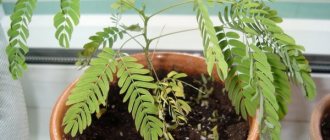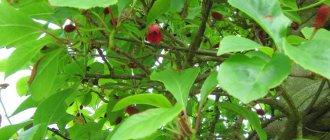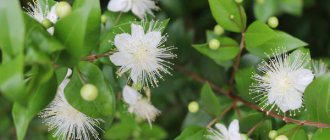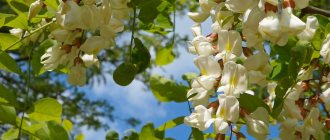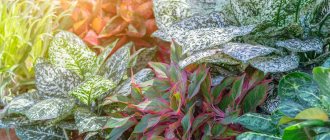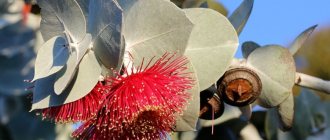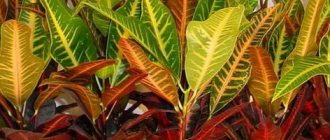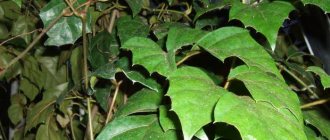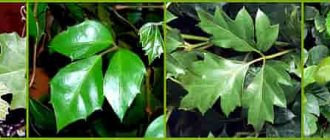Common myrtle
Myrtle (Myrtus) is a genus of evergreen woody plants in the myrtle family (Myrtaceae). The taxonomy of this family has undergone significant changes in recent years. Previously, several dozen plants were assigned to the genus, which, thanks to modern research methods, were transferred to closely related or isolated into independent genera of the Myrtle family. Currently, only the common myrtle (Myrtus communis) and the Saharan or African (Myrtus nivellei) are included in this genus. However, there is still debate among botanists whether the Saharan myrtle is a separate species or an isolated population of the common myrtle that is on the verge of extinction. It is quite possible that only the common myrtle is the only true representative of the genus.
| #FOTO1# |
This is a multi-stemmed tree or shrub, reaching 5 m in height and 1.5-2 m in diameter. The leaves are entire, lanceolate, leathery, 3-6 cm (in some varieties 1-1.5 cm), located on the branches opposite or in whorls of three. Numerous essential glands are visible in the leaves when rubbed, thanks to which a specific aroma appears when rubbed. The flowers are five-petalled, mostly white, with numerous stamens and a spicy aroma, pollinated by insects. Flowering time is spring-summer. After flowering, elongated small, 1-1.5 cm, dark blue or black edible berries are produced (there are varieties with white and pink fruits).
The exact origins of myrtle are unknown, although it is native to the Mediterranean, North Africa and the Middle East.
Myrtle gets its name from the Greek myrtos or, probably, the more ancient myron, which means “incense.” Another well-known name for the common myrtle and some related plants of the myrtle family is Arrayán, which comes from the Arabic Ar-Rayhan (“aromatic”).
How is Myrtle useful?
This plant can replace an entire pharmacy . When rubbed, the leaves emit a very strong odor that resembles the aroma of a coniferous tree. This smells like myrtle essential oil contained in the leaves of the plant. In addition to these oils, myrtle contains flavonoids, camphor, polyphenols, saponins and other substances.
has been used in folk medicine for a long time Tinctures, lotions, and decoctions are made from it.
Important: It is useful for the prevention and treatment of colds by simply chewing fresh myrtle leaves. Antimicrobial properties will help kill pathogens.
Myrtle in an apartment perfectly improves the health of the air. The leaves secrete phytoncides - substances that have bactericidal properties and destroy pathogenic microbes.
Surprisingly, a small tree can destroy up to 20% of streptococci and 40% of staphylococci.
The chemical composition of this amazing plant includes more than ten useful substances that have a beneficial effect on the human body.
How to care for a myrtle tree at home
The bush is very demanding on growing conditions and problems often arise when growing it. Any errors in care are manifested in appearance and can cause the death of the plant. Therefore, it is necessary to study some nuances in order to create suitable conditions for growth and flowering. First of all, you should remember that myrtle needs a period of rest, which is why its care should vary at different times of the year.
Although the myrtle tree is very capricious, it is very tenacious - it can come to life after a fire and freezing.
Location and lighting
The tree loves bright light. Lack of lighting provokes leaf loss. But in hot weather it needs to be slightly shaded.
It is not advisable to place a myrtle tree in the bedroom. The aroma emitted by the leaves can cause migraines and insomnia.
Humidity and temperature
Myrtle prefers cool weather and high humidity. Therefore, it requires constant spraying, which is especially important in spring and autumn - it is at this time that it grows intensively.
In summer, the myrtle tree should be kept at a temperature of 18-20⁰, in winter - at 6-8 degrees Celsius. It can overwinter at room temperature, but in this case, abundant watering and regular spraying are required (the plant is not sprayed in a cool room).
In a warm, dry room, myrtle often loses its leaves. But if you provide it with the necessary moisture, it will soon turn green again.
Soil and pot
The best substrate is humus, sand, peat and turf soil mixed in equal proportions. Another option for soil mixture is sand, humus, peat, turf and clay soil, taken in a ratio of 1:2:2:2:2. You can take store-bought soil, but its acidity should range between 5-6.
You need to take a pot half the size of the tree crown, capable of containing the entire root system. It should have enough holes for drainage. Expanded clay, polystyrene foam, broken brick or nut shells must be poured onto the bottom to avoid stagnation of water.
How to water
Water the shrub immediately after the top layer of soil substrate has dried. The soil should be kept moist at all times.
Both soil drying out and water stagnation should not be allowed. Both situations will lead to the death of the plant.
For irrigation you need well-settled soft water, always at room temperature.
If the soil is dry, then the plant along with the pot should be placed in a bowl filled with water for several hours.
Fertilizers and fertilizers
Myrtle should be fed weekly. When choosing fertilizers, you need to take into account the desired result. If you want to get a miniature, abundantly flowering tree, then use phosphorus fertilizers. If you prefer a tall tree with rare flowering, then nitrogen fertilizing will be required. You can use complex fertilizers, but only those intended for indoor plants with decorative foliage.
Fertilizers are applied only in liquid form, the day after dilution.
Trimming
Particular attention must be paid to pruning and pinching the plant, which will give it the desired shape. With constant pruning of the top, the myrtle will look like a shrub, and with pruning of the sides it will turn into a lush tree. If you do not form the crown, it will become pyramidal.
If you constantly pinch the edges of the branches, the plant will acquire special splendor. But at the same time the flowering will be less abundant.
The optimal time for pruning is spring. But in this case, the plant will bloom only next year. To enjoy the annual blooms, it is recommended to prune the plant after flowering. You can pinch all year round.
Immediately after pruning, fertilizer must be applied. At the same time, planned feeding is not canceled.
Transfer
Young bushes require annual replanting. It is enough to replant adult plants once every three to four years. Replanting is required for purchased myrtles.
The bush needs to be replanted when the roots begin to peek out from the drainage holes.
The optimal time for transplantation is early spring.
WHEN TRANSPLANTING A PLANT, YOU NEED TO MAKE SURE THAT THE ROOT NECK IS LOCATED ABOVE THE SOIL LEVEL. OTHERWISE, THE DEVELOPMENT OF VARIOUS DISEASES, ESPECIALLY ROT, IS POSSIBLE.
Possible problems
In order for the myrtle tree to delight with its beauty for a long time, it is necessary to carefully monitor the condition of the plant and provide timely assistance.
| Problem | Cause |
| leaves curl, turn yellow and fall off | lack of light and moisture |
| the stems stretch out, the foliage becomes smaller and fades | bad light |
| the leaves lose their shine, turn yellow, become deformed and curl, the edges become wavy | the light is too bright |
| the leaves are falling off | poor lighting, lack of moisture, high air temperature |
| rotting of the root system | moisture stagnation |
| lack of flowering | poor watering schedule, low humidity, improper lighting, frequent rearrangements or pruning, diseases, parasites |
Medicinal properties or treatment of myrtle
- strengthens the immune system;
- helps in the treatment of colds;
- used for diseases of the upper respiratory tract;
- has a wound healing effect;
- is a natural antiseptic;
- has an analgesic effect;
- successfully fights various tumors;
- excellent antiallergic agent.
And this is not the entire list of beneficial properties of this plant.
Myrtle oil is also successfully used in cosmetology.
Cosmetics using this oil moisturize and nourish the epidermis, treat problematic skin with acne. This essential oil also strengthens hair and improves hair structure.
- For skin diseases, lotions made from myrtle decoction are successfully used;
- If you have a sore throat, rinsing with this decoction will bring noticeable relief and a quick positive effect. Such rinses will be especially helpful for children;
- Myrtle infusion will help in the treatment of herpes. To do this, apply a cotton pad moistened with infusion to the affected area;
- For eye diseases, apply lotions from myrtle infusion directly to the eyes, and also take the healing tincture internally;
- An alcohol tincture with myrtle will help with purulent otitis media, bronchitis, pneumonia, etc.;
- 5 drops of myrtle oil dissolved in hot water is an excellent remedy for inhalation for colds;
- Rubbing myrtle oil into the gums will help with periodontal disease;
- Myrtle oil is a good rubbing remedy for various colds.
Appearance
Myrtle is a low shrub (the maximum height of some subspecies is 5 meters). The leaves are dark green, round, pointed at the end. The inflorescences are white, round and fluffy. The fruits are blue-black berries with a diameter of about 1 cm.
There are two types of myrtle tree:
- ordinary - distinguished by small foliage and beige or slightly reddish inflorescences;
- Saharan - is an endangered species, grows in the highlands of Southern Algeria and the Republic of Chad.
Appearance
Myrtle is a low shrub (the maximum height of some subspecies is 5 meters). The leaves are dark green, round, pointed at the end. The inflorescences are white, round and fluffy. The fruits are blue-black berries with a diameter of about 1 cm.
There are two types of myrtle tree:
- ordinary - distinguished by small foliage and beige or slightly reddish inflorescences;
- Saharan - is an endangered species, grows in the highlands of Southern Algeria and the Republic of Chad.
Application
In cooking
- in Italy, a liqueur called “myrto” is made from the fruits of the myrtle tree;
- in France they make jam from world berries;
- dried myrtle fruits are used in the production of certain types of sausages;
- myrtle leaves are added to pickles and marinades;
- meat and fish cooked on the grill using the bark and branches of the myrtle tree acquire a unique aroma;
- Myrtle adds bitterness to dishes, so it should be added to food in very small quantities.
Stewed fish
Cut the carcass of any lean fish into pieces of the required size. Cut 2 carrots into slices, 1 onion into large rings. Place the fish and vegetables in a thick-walled pan or cauldron, add a few myrtle leaves, salt and pepper to taste. Pour half a glass of water and simmer until done.
Chicken with vegetables
Prepare 1 kg of chicken fillet, cut into small cubes. Chop an onion, 2 carrots, a small zucchini, cauliflower, tomato and bell pepper. Take a deep saucepan or roasting pan and lay out the food in layers; onion, poultry, carrot, zucchini, pepper, tomato, cabbage. Place one myrtle leaf on each layer. Add a little water and simmer until done.
Application
In cooking
- in Italy, a liqueur called “myrto” is made from the fruits of the myrtle tree;
- in France they make jam from world berries;
- dried myrtle fruits are used in the production of certain types of sausages;
- myrtle leaves are added to pickles and marinades;
- meat and fish cooked on the grill using the bark and branches of the myrtle tree acquire a unique aroma;
- Myrtle adds bitterness to dishes, so it should be added to food in very small quantities.
Stewed fish
Cut the carcass of any lean fish into pieces of the required size. Cut 2 carrots into slices, 1 onion into large rings. Place the fish and vegetables in a thick-walled pan or cauldron, add a few myrtle leaves, salt and pepper to taste. Pour half a glass of water and simmer until done.
Chicken with vegetables
Prepare 1 kg of chicken fillet, cut into small cubes. Chop an onion, 2 carrots, a small zucchini, cauliflower, tomato and bell pepper. Take a deep saucepan or roasting pan and lay out the food in layers; onion, poultry, carrot, zucchini, pepper, tomato, cabbage. Place one myrtle leaf on each layer. Add a little water and simmer until done.

